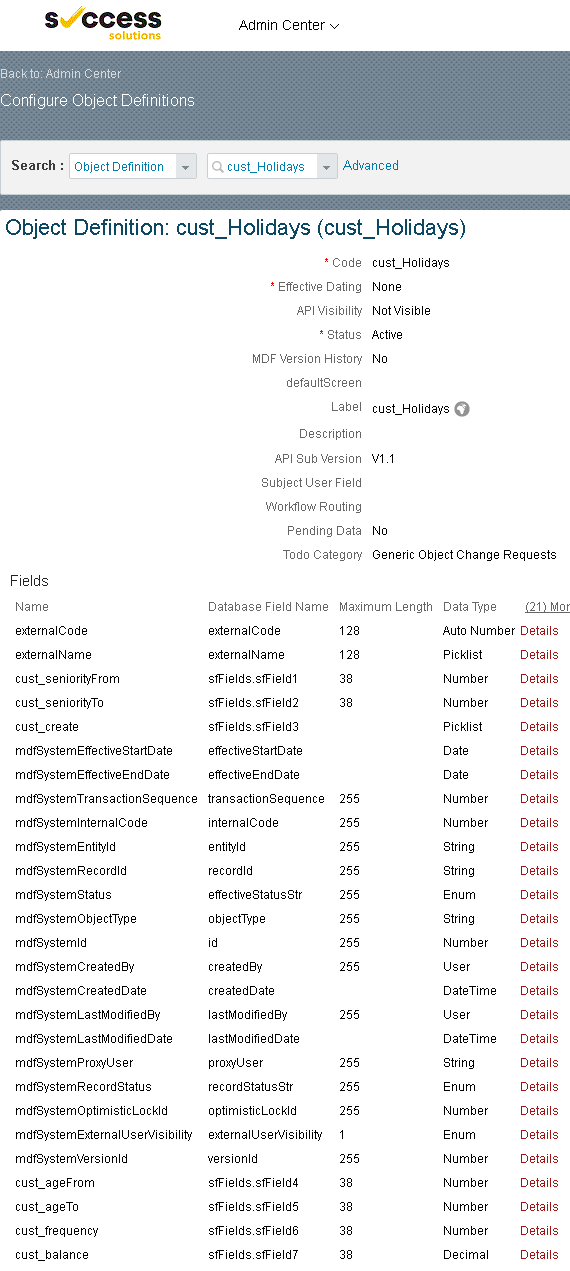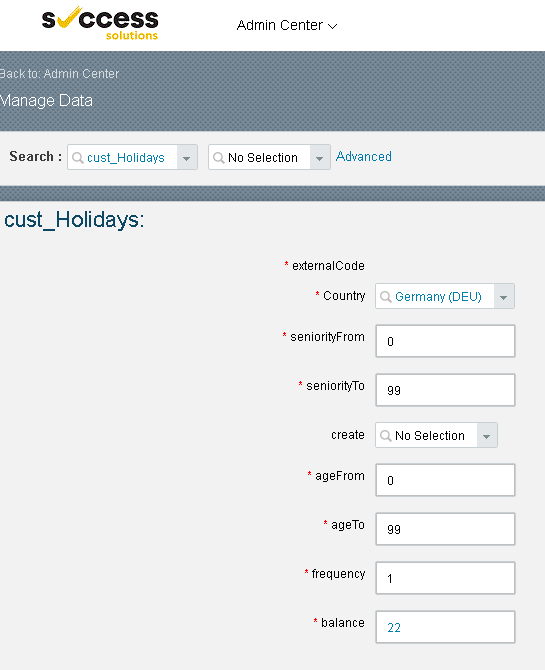
- SAP Community
- Products and Technology
- Human Capital Management
- HCM Blogs by Members
- Time off configuration for easy customer managemen...
Human Capital Management Blogs by Members
Gain valuable knowledge and tips on SAP SuccessFactors HCM suite and human capital management market from member blog posts. Share your insights with a post of your own.
Turn on suggestions
Auto-suggest helps you quickly narrow down your search results by suggesting possible matches as you type.
Showing results for
jsysel
Participant
Options
- Subscribe to RSS Feed
- Mark as New
- Mark as Read
- Bookmark
- Subscribe
- Printer Friendly Page
- Report Inappropriate Content
03-21-2017
6:18 AM
Whenever building time off solution it is typically divided into several rules based on each country/time type. What about to find a solution that is easy to manage from end customer and overall simple configuration that covers all possible scenarios.

2. This is how it looks like when adding new entry, as you can see all entries are mandatory but it's easy for customer to fill in these fields:
a) ExternalCode is autonumber so filled automatically
b) country is necessary and it is not possible to continue without country definition
c) seniorityFrom - SeniorityTo are defaulted to 0 and 99
d) create - this is prepared for Recurring/Permanent account - in our scenario we have only recurring accounts so we don't use this
e) ageFrom - ageTo are defaulted to 0 and 99
f) frequence is really important and can be any number, this is used in the rule and will describe there (just keep in mind that you will need it)
g) balance - does it make sense to use it without balance? 😉

3. next step is to change the definition of the Accrual Rule Variables object, for our scenario we need to add another field (age) to use it during the rule definition

4. before going to the rule definition let's prepare the import file for the first use. You can see the data below and how easy/hard is to make some changes or adding new country (it needs additional steps but still easy to configure by the customer). It's easy way to change just one entry or upload more changes at once.

5. Let's focus on the rule
a) first thing we need to is calculation of the seniority
b) next is calculation of the age and storing it in the accrual rule variables object - this is the reason why we added a field in step 3
c) The calculation is based on balance/frequency - this approach allows us to be independent on the periodicity of the time account type e.g. we got and annual accrual rule for Czech Republic (see step 4) and we have balance 25/1 so each year the employee will get 25 days. Another example is for GBR where the calculation is with frequency 12. The GBR time account is with accrual frequency monthly and the calculation will be 22/12 (for seniority 0-2). Simple and easy to understand and very flexible.
d) the lookup table definition is really straightforward, based on the seniority, age and country of the employee (based on JobInfo) we can easily select right balance for each individual.

Is this all? No, it's just an example. What are other topics to cover?
You can build all of them, maybe you will need to make some adjustment to the main lookup table to cover your customer specific requirements but that's all.
Could we use it for different time types other then holidays?
How much time is possible to save with this approach?
We are doing time off for 48 countries and 3 of them have special exceptions that aren't relevant to others at all, what to do?
Any other questions?
- Define custom object with all required customer criteria - for our scenario we need following attributes: Country, seniority, age, frequency and balance

2. This is how it looks like when adding new entry, as you can see all entries are mandatory but it's easy for customer to fill in these fields:
a) ExternalCode is autonumber so filled automatically
b) country is necessary and it is not possible to continue without country definition
c) seniorityFrom - SeniorityTo are defaulted to 0 and 99
d) create - this is prepared for Recurring/Permanent account - in our scenario we have only recurring accounts so we don't use this
e) ageFrom - ageTo are defaulted to 0 and 99
f) frequence is really important and can be any number, this is used in the rule and will describe there (just keep in mind that you will need it)
g) balance - does it make sense to use it without balance? 😉

3. next step is to change the definition of the Accrual Rule Variables object, for our scenario we need to add another field (age) to use it during the rule definition

4. before going to the rule definition let's prepare the import file for the first use. You can see the data below and how easy/hard is to make some changes or adding new country (it needs additional steps but still easy to configure by the customer). It's easy way to change just one entry or upload more changes at once.

5. Let's focus on the rule
a) first thing we need to is calculation of the seniority
b) next is calculation of the age and storing it in the accrual rule variables object - this is the reason why we added a field in step 3
c) The calculation is based on balance/frequency - this approach allows us to be independent on the periodicity of the time account type e.g. we got and annual accrual rule for Czech Republic (see step 4) and we have balance 25/1 so each year the employee will get 25 days. Another example is for GBR where the calculation is with frequency 12. The GBR time account is with accrual frequency monthly and the calculation will be 22/12 (for seniority 0-2). Simple and easy to understand and very flexible.
d) the lookup table definition is really straightforward, based on the seniority, age and country of the employee (based on JobInfo) we can easily select right balance for each individual.

Is this all? No, it's just an example. What are other topics to cover?
- Average FTE
- Rounding of the balance
- Hire rule
- Termination Rule
- PEP rule
- Permanent account 😉
You can build all of them, maybe you will need to make some adjustment to the main lookup table to cover your customer specific requirements but that's all.
Could we use it for different time types other then holidays?
- sure, why not, maybe just add another field with own generic object reference to the time account type
How much time is possible to save with this approach?
- based on the number of countries, if you are implementing 1-2 countries the added value isn't high but when doing more than 10 it has significant positive effect on the delivery of the time off configuration (40 - 70 % less time required)
We are doing time off for 48 countries and 3 of them have special exceptions that aren't relevant to others at all, what to do?
- well, maybe try to incorporate into the rules and if you cannot, you can create second variant of this rule with exceptions
Any other questions?
- SAP Managed Tags:
- SAP SuccessFactors Employee Central,
- SAP SuccessFactors HXM Suite
You must be a registered user to add a comment. If you've already registered, sign in. Otherwise, register and sign in.
Labels in this area
-
1H 2024 Product Release
5 -
2H 2023 Product Release
1 -
ACCRUAL TRANSFER
1 -
Advanced Workflow
1 -
AI
1 -
AI & Skills Ontology
1 -
Anonymization
1 -
BTP
1 -
Business Rules
2 -
Canvas Report
1 -
Career Development
1 -
Certificate-Based Authentication
1 -
Cloud Identity Services
1 -
Cloud Platform Integration
1 -
Common Super Domain
1 -
Compensation
1 -
Compensation Information Management
1 -
Compensation Management
1 -
Compliance
2 -
Content
1 -
Conversational AI
2 -
CSD
1 -
Custom Data Collection
1 -
Custom event
1 -
custom portlet
1 -
Data & Analytics
1 -
Data Integration
1 -
Dayforce
1 -
deep link
1 -
deeplink
1 -
Delimiting Pay Components
1 -
Deprecation
1 -
EC Payroll
1 -
Employee Central
1 -
Employee Central Global Benefits
1 -
Employee Central Integration (Inc. EC APIs)
1 -
Employee Central Payroll
2 -
employee profile
2 -
Employee Rehires
2 -
external terminal
1 -
external time events
1 -
Generative AI
2 -
Getting Started
1 -
Global Benefits
1 -
Guidelines
1 -
h12024
1 -
H2 2023
1 -
HCM
1 -
HR
2 -
HR Data Management
1 -
HR Transformation
1 -
ilx
1 -
Incentive Management Setup (Configuration)
1 -
Integration Center
2 -
Integration Suite
1 -
Intelligent Services
1 -
internal mobility
1 -
Introduction
1 -
Learning
3 -
LMS
2 -
LXP
1 -
Massively MDF attachments download
1 -
Mentoring
1 -
Metadata Framework
1 -
Middleware Solutions
1 -
OCN
1 -
OData APIs
1 -
ONB USA Compliance
1 -
Onboarding
2 -
Opportunity Marketplace
1 -
Pay Component Management
1 -
PCE
1 -
Platform
1 -
portlet
1 -
POSTMAN
1 -
Predictive AI
2 -
Recruiting
1 -
recurring payments
1 -
RISE PCE
1 -
Role Based Permissions (RBP)
2 -
S4 HANA On-Premise
1 -
SAP Build CodeJam
1 -
SAP Build Marketplace
1 -
SAP CPI (Cloud Platform Integration)
1 -
SAP HCM
1 -
SAP HCM (Human Capital Management)
3 -
SAP HCM ECC
1 -
SAP HR Solutions
2 -
SAP Integrations
1 -
SAP release
1 -
SAP successfactors
7 -
SAP SuccessFactors Customer Community
1 -
SAP SuccessFactors OData API
1 -
SAP Workzone
1 -
SAP-PAYROLL
1 -
self-service migration
1 -
Skills
1 -
Skills Management
1 -
sso deeplink
1 -
Stories in People Analytics
3 -
Story Report
1 -
SuccessFactors
3 -
SuccessFactors Employee central home page customization.
1 -
SuccessFactors Onboarding
1 -
successfactors onboarding i9
1 -
SuccessFactors Platform
1 -
Table Report
1 -
talent
1 -
Talent Intelligence Hub
2 -
talentintelligencehub
1 -
talents
1 -
Tax
1 -
Tax Integration
1 -
TIH
1 -
Time Accounts
1 -
Time Management implementation links
1 -
Workflows
1 -
XML Rules
1
- « Previous
- Next »
Related Content
- Should I wait for SAP SuccessFactors Payroll (aka Next-Gen Cloud Payroll)? in Human Capital Management Blogs by Members
- First Half 2024 Release: What's New in SAP SuccessFactors Employee Central Payroll in Human Capital Management Blogs by SAP
- Time Management links compilation in Human Capital Management Blogs by Members
- Identifying future dated transactions during a termination event in Employee Central in Human Capital Management Blogs by SAP
- Speeding up your SAP HCM move to the cloud in 2024 - Part 2: Customer Evolution Kit for HCM in Human Capital Management Blogs by SAP
Top kudoed authors
| User | Count |
|---|---|
| 5 | |
| 5 | |
| 4 | |
| 2 | |
| 2 | |
| 2 | |
| 1 | |
| 1 | |
| 1 | |
| 1 |